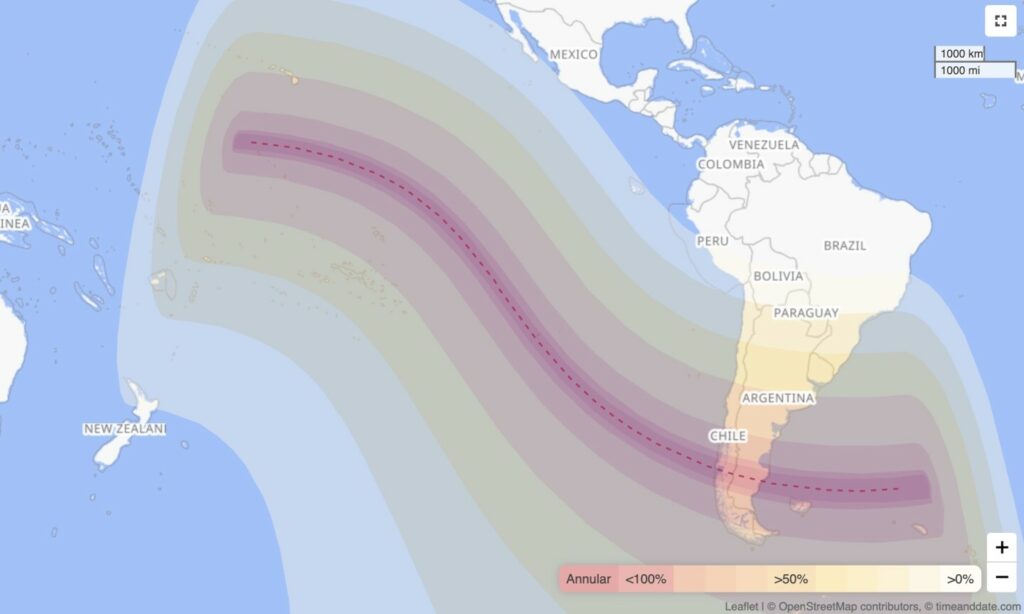On October 2, 2024, a rare annular solar show will sweep across the Pacific Ocean and South America. An annular solar eclipse, also known as a “ring of fire” eclipse, is a phenomenon when we see the moon pass in front of the sun without completely covering it, resulting in a blazing ring around the moon. The one in October will last for as long as 7 minutes and 25 seconds in some places.
Here’s what you need to know about planning a last-minute trip to see the 2024 annular solar eclipse.
The path of the October 2024 solar eclipse will mostly encompass southern areas of South America.
Courtesy of Time and Date AS
Path of the October 2024 “ring of fire” solar eclipse
While the eclipse’s journey will span 8,800 miles, very little of it will actually be above land. It will start roughly 1,000 miles south of Hawai‘i in the Pacific Ocean and end about 350 miles north of South Georgia in the Atlantic Ocean, covering Easter Island and southern parts of mainland Chile and Argentina in temporary darkness. Whereas roughly 44 million people were situated within the path of totality for the April 8, 2024, eclipse in North America (and many more traveled to see it), only 175,000 people live within the path of the October 2 annular solar eclipse. That’s all to say, if you go, you could be in a rarefied group of travelers.
Where to see the October 2024 solar eclipse
This is your chance to see not only an amazing solar phenomenon but also to view it from the spectacular Perito Moreno National Park in Patagonia, Argentina.
Photo by Galyna Andrushko/Shutterstock
Perito Moreno National Park, Patagonia, Argentina
Part of the larger Patagonia area, Perito Moreno is famed for its diverse landscapes, including a 100 square-mile glacier and high basaltic plateaus, plus an array of wildlife, such as the endangered Andean condor and guanacos, a wild cousin to llamas.
Throughout the week leading up to the event, Parque Patagonia will be hosting events, ranging from scientific presentations to telescope demonstrations, in the park itself and in the towns of Perito Moreno, Los Antiguos, and Lago Posadas (where there are also options for camping and lodging). Visitors can also explore the Cañadón Pinturas Gateway, with more than 20 miles of nature trails, and Cueva de las Manos Provincial Park, a UNESCO World Heritage site with an impressive collection of 8,000-year-old rock art. El Calafate Airport is the closest airport—there are daily three-hour flights from Buenos Aires.
The October solar eclipse will occur here between approximately 4 p.m. and 6:20 p.m. local time, and the maximum eclipse will take place at around 5:25 p.m.
Easter Island will make for a dramatic setting to view the upcoming solar eclipse.
Courtesy of Thomas Griggs/Unsplash
Easter Island, Chile
Rapa Nui National Park is on Chile’s Easter Island in the southeastern Pacific Ocean. The UNESCO World Heritage site is renowned for the enormous stone statues known as moai. Carved by the island’s early inhabitants, who had come from Polynesia between the 13th and 16th centuries, the statues represent their ancestors and are scattered throughout the park. The entire island is within the eclipse’s path, although the duration will differ depending on where you’re located. At Ana o Heu, the northernmost point, it will last 5 minutes and 59 seconds, while the eclipse will be visible for 6 minutes and 28 seconds at Orongo, the most southerly point. Rapa Nui is a five-hour flight from Santiago, Chile. Organizations like Sky & Telescope and Eclipse Traveler offer tours for those who would rather not travel independently.
The event will begin at around 12:23 p.m. and will ends at approximately 3:52 p.m. on October 2, with the maximum coverage of the sun occurring at 2:07 p.m.
Upcoming eclipses
Mark your calendars. After the October 2024 event, the next annular solar eclipses will occur on February 17, 2026 (in Antarctica); February 6, 2027 (in Chile, Argentina, Uruguay, Côte d’Ivoire, Ghana, Togo, Benin, and Nigeria); January 26, 2028 (in the Galápagos Islands, mainland Ecuador, Brazil, French Guiana, Portugal, Morocco, and Spain); and June 1, 2030 (in Algeria, Tunisia, Greece, Türkiye, Russia, Kazakhstan, China, and Japan). The next total solar eclipse, which will be visible in Greenland, Iceland, Spain, Russia, and a small area of Portugal, will occur on August 12, 2026.
Source link : http://www.bing.com/news/apiclick.aspx?ref=FexRss&aid=&tid=66d0d6888cbc4030a386129e736555f9&url=https%3A%2F%2Fwww.afar.com%2Fmagazine%2Fwhere-and-how-to-see-the-october-2024-solar-eclipse&c=14352474379020517230&mkt=en-us
Author :
Publish date : 2024-08-29 08:39:00
Copyright for syndicated content belongs to the linked Source.
